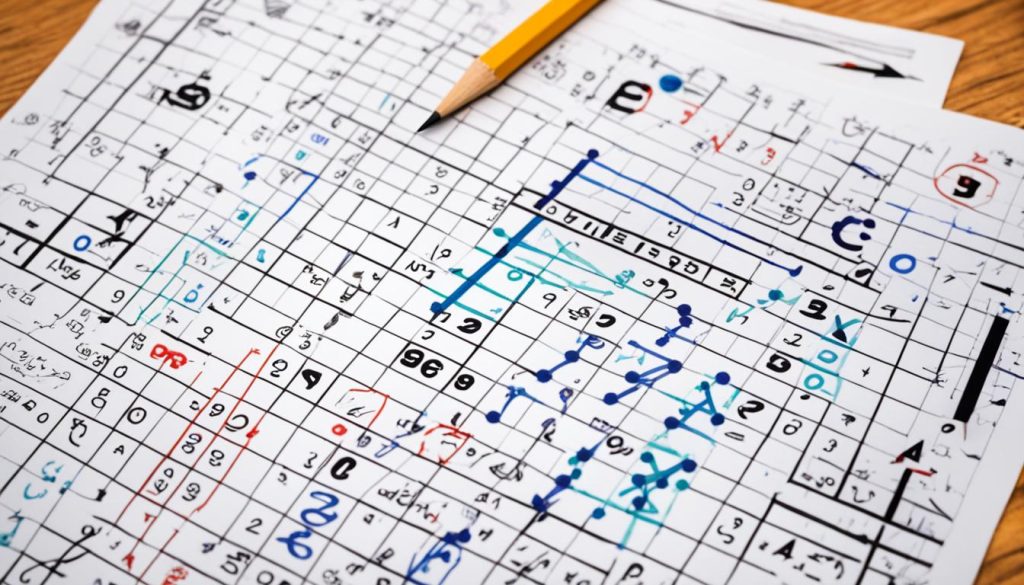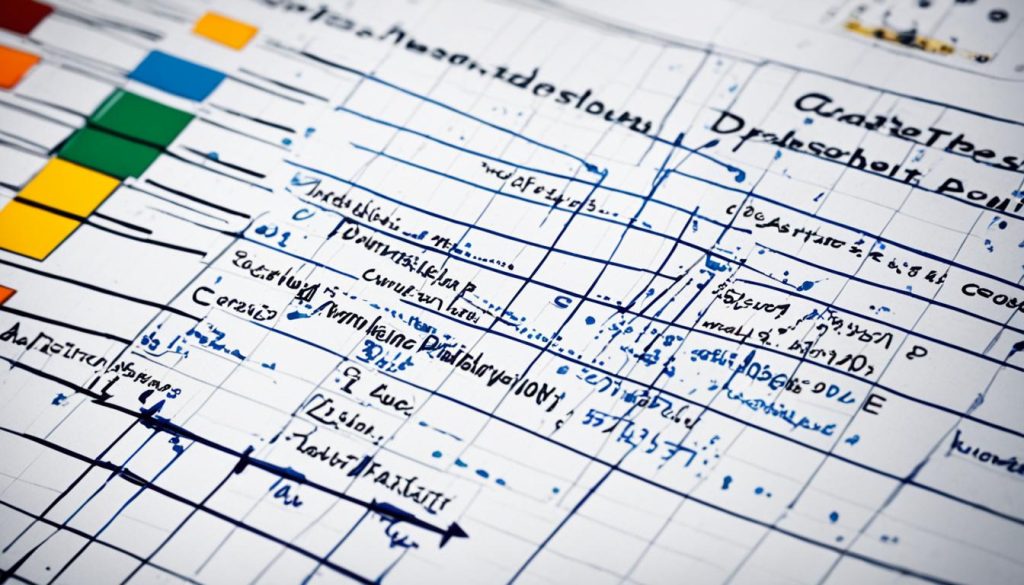Ace Your Exam: AP Stats Practice Test Prep
Are you preparing for the AP Stats exam? Looking for effective practice test prep? Look no further! In this section, we will provide you with comprehensive AP Stats Practice Test prep to help you maximize your score on the exam. Our resources are tailored to the latest format and content provided by the College Board, ensuring you are fully prepared.

Key Takeaways:
- Prepare for the AP Stats exam with our comprehensive practice test prep.
- Our resources are tailored to the latest format and content provided by the college board.
- Maximize your score by gaining a solid understanding of key concepts and topics.
- Familiarize yourself with the exam format and content to better prepare for the test.
- Master effective test-taking strategies to approach different question types.
Understanding AP Statistics.
Before diving into the practice test prep, it’s essential to have a solid understanding of AP Statistics. This section will cover the key concepts and topics you need to know, ensuring a strong foundation for your exam preparation.
AP Statistics is a high school course that introduces students to the principles of statistics and its applications. It provides a comprehensive overview of statistical analysis, data interpretation, and probability theory.
By mastering AP Statistics, students gain valuable skills in data analysis, critical thinking, and problem-solving that are applicable to various fields such as social sciences, economics, and healthcare.
Here are some essential topics you will encounter in AP Statistics:
- Descriptive Statistics: Learn how to summarize and describe data using measures of central tendency, variability, and graphical representations.
- Inferential Statistics: Understand how to draw conclusions and make predictions based on sample data, employing techniques such as hypothesis testing and confidence intervals.
- Experimental Design: Explore strategies for designing experiments and conducting studies to collect valid and reliable data.
- Probability: Delve into the fundamental concepts of probability theory, including the laws of probability, conditional probability, and probability distributions.
- Regression Analysis: Discover how to analyze the relationship between variables and make predictions through regression models.
Developing a strong grasp of these concepts and topics is crucial for success in AP Statistics. It lays the groundwork for effectively applying statistical methods, interpreting data, and drawing meaningful conclusions.
“Statistics is the grammar of science.” – Karl Pearson
Having a solid understanding of AP Statistics not only helps you excel in the exam but also equips you with invaluable skills that are highly sought after in college and the professional world.
Exam Format and Content Review.
To better prepare for the AP Statistics exam, it’s crucial to familiarize yourself with its format and content. Understanding what to expect on the test will enable you to focus your study efforts and approach the exam with confidence. In this section, we will review essential topics such as data analysis, probability, and regression analysis, equipping you with the necessary knowledge to succeed.
Exam Format
The AP Statistics exam consists of two sections: multiple-choice questions and free-response questions. The multiple-choice section comprises 50% of your total score and includes 40 questions. This section assesses your ability to analyze and interpret data, make inferences, and perform statistical calculations.
The free-response section contributes the other 50% of your score and requires you to answer six questions. These questions may include investigative tasks, data analysis, and theoretical or experimental probabilities. You’ll demonstrate your understanding of statistical concepts and your ability to apply them to real-world scenarios.
Content Review
To excel on the AP Statistics exam, you need a solid grasp of fundamental concepts and techniques. Let’s delve into some of the key content areas:
- Data Analysis: Master the art of interpreting, summarizing, and representing data. Understand measures of central tendency, variability, and graphical displays, such as histograms and box plots.
- Probability: Explore the fundamental principles of probability theory, including independence, conditional probability, and probability distributions. Develop your skills in calculating probabilities and understanding sampling distributions.
- Regression Analysis: Learn to analyze the relationship between variables through regression models. Understand the concepts of correlation, least-squares regression, and residuals. Apply regression techniques to make predictions and draw conclusions.
“Data analysis and probability are essential pillars of AP Statistics. By mastering these concepts, you’ll be well-equipped to tackle a wide range of statistical problems and succeed on the exam.” – Dr. Jennifer Lee, Statistics Professor
Now that you have a clear understanding of the exam format and the essential content areas, you can focus your study efforts efficiently. In the next section, we will delve into effective test-taking strategies to maximize your performance on the AP Statistics exam.

Test Taking Strategies for AP Stats.
Mastering effective test-taking strategies is vital to achieving a high score on the AP Statistics exam. In this section, we will share valuable tips and techniques to help you approach different question types and manage your time effectively during the test.
Tips for Multiple Choice Questions
- Read carefully: Take your time to understand the question and all the answer choices before selecting the best option.
- Eliminate wrong answers: Use the process of elimination to eliminate obvious incorrect answers and narrow down your choices.
- Guess strategically: If you’re unsure, make an educated guess. Eliminate the least likely answers and choose from the remaining options.
Tips for Free Response Questions
- Understand the prompt: Read the prompt carefully and make sure you fully understand what the question is asking for.
- Show your work: Clearly show your steps and calculations to demonstrate your thought process and reasoning.
- Use proper notation: Use appropriate statistical notation and terminology to convey your ideas accurately.
Remember, neatness and clarity are important in your free response answers. Organize your work and clearly label each part of your response to ensure it is easy for the grader to follow.
Time Management Tips
Managing your time effectively during the AP Statistics exam is essential to complete all the questions within the allotted time frame. Consider the following tips:
- Plan your time: Allocate specific time intervals for each question or section based on the number of points or weightage they carry.
- Start with what you know: Begin with the questions you are most confident about to gain momentum and build confidence.
- Mark and revisit: If you’re unsure about a question, mark it and come back to it later. Don’t waste too much time on a single question.
- Pace yourself: Monitor your time regularly and make sure you’re progressing at a steady pace. Don’t spend too much time on one question and risk running out of time for the remaining ones.
By implementing these test-taking strategies, you can approach the AP Statistics exam with confidence and maximize your chances of achieving a high score. Remember to practice these techniques during your preparation to familiarize yourself with their application. Now, let’s move on to the next section, where we will provide you with a collection of AP Stats practice questions to further enhance your preparation.
AP Stats Practice Questions.
Put your knowledge to the test with our collection of AP Stats practice questions. These questions are designed to mimic the difficulty and format of the actual exam, allowing you to gauge your understanding and identify areas for improvement.
Practicing with AP Stats questions is essential for mastering the content and gaining confidence in your abilities. Our practice questions cover a wide range of topics, including data analysis, probability, hypothesis testing, and more.
By working through these practice questions, you’ll not only familiarize yourself with the content but also develop valuable problem-solving skills. You’ll learn how to approach different types of questions, apply statistical concepts, and interpret data effectively.
“Practice makes perfect. By regularly challenging yourself with AP Stats practice questions, you’ll sharpen your skills and build the confidence needed to excel on the exam.”
To give you a glimpse of what to expect, here’s a sample AP Stats practice question:
- A survey was conducted to determine the average number of hours high school students spend studying each week. The data collected is summarized in the table below:
| Number of Hours Studying | Frequency |
|---|---|
| 0-2 | 15 |
| 2-5 | 30 |
| 5-8 | 25 |
| 8-10 | 10 |
| 10-12 | 20 |
Based on the table, what is the median number of hours high school students spend studying each week?
Choose the correct answer from the options below:
- A) 2-5 hours
- B) 5-8 hours
- C) 8-10 hours
- D) 10-12 hours

Practice analyzing data, calculating probabilities, and solving statistical problems with our extensive collection of AP Stats practice questions. Strengthen your skills and boost your confidence as you prepare for the AP Statistics exam.
Tips for Data Analysis and Interpretation.
Being proficient in data analysis and interpretation is crucial to excel in AP Statistics. In this section, we will provide you with valuable tips and techniques to enhance your data analysis abilities and improve your ability to interpret statistical results accurately.
1. Understand the Data
Before diving into analysis, it’s essential to have a clear understanding of the data you are working with. Take the time to examine the variables, their measurement scales, and any potential outliers or missing values. This preliminary step will help you make informed decisions during the analysis process.
2. Choose the Right Analysis Methods
Selecting appropriate analysis methods is key to obtaining meaningful insights from your data. Consider the research question or hypothesis you want to explore and choose the appropriate statistical techniques accordingly. Whether it’s hypothesis testing, regression analysis, or ANOVA, ensure that your chosen method aligns with your study objectives.
3. Visualize the Data
Visual representations of data can often provide valuable insights at a glance. Utilize charts, graphs, and histograms to explore patterns, relationships, and distributions within your data. Clear visualizations not only make interpretation easier but also enable effective communication of your findings.
4. Validate Your Assumptions
Statistical analyses often rely on certain assumptions. It’s important to validate these assumptions to ensure the accuracy and reliability of your results. Check for normality, independence, and homogeneity of variance, among others, depending on the analysis technique being used.
5. Consider Context and Causality
When interpreting your results, always consider the context in which your data was collected. Understand the limitations and potential biases in your study design. Additionally, remember that statistical significance does not necessarily imply causality. Analyze your findings within the broader context of the research question and existing literature.
“The most important thing about data analysis is not the data. It is the questions.” – Edward Tufte
By following these tips for data analysis and interpretation, you’ll be equipped with the skills and knowledge necessary to effectively analyze and interpret statistical data. Remember, practice and experience are key in honing your data analysis skills, so don’t shy away from tackling challenging datasets and real-world problems.
| Data Analysis Tips | Interpretation Techniques |
|---|---|
| 1. Understand the data | 1. Contextualize the findings |
| 2. Choose the right analysis methods | 2. Consider limitations and biases |
| 3. Visualize the data | 3. Analyze within the broader context |
| 4. Validate assumptions | 4. Evaluate causality |
Remember, the true power of data lies in its analysis and interpretation. By mastering these skills, you’ll be well-prepared to tackle complex statistical problems and draw meaningful conclusions from the data at hand.
Conclusion.
In conclusion, our comprehensive AP Stats Practice Test prep resources are designed to equip you with the tools and knowledge necessary to confidently approach the exam and maximize your score. Our tailored materials, created in accordance with the latest format and content provided by the College Board, ensure that you are well-prepared for the challenges of the AP Statistics exam.
By combining our resources with a solid understanding of the content and effective test-taking strategies, you will be able to excel in AP Statistics. Whether you need to review key concepts, familiarize yourself with the exam format, or practice with realistic questions, our resources provide you with everything you need to succeed.
Start your preparation today and make the most of your AP Stats exam. With our comprehensive prep resources and your dedication, you can confidently tackle the exam and achieve the results you desire. Don’t leave your success to chance – trust our proven approach to help you ace your AP Stats exam.